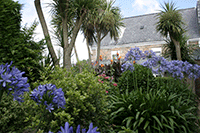The Royal Horticultural Society (RHS) is calling on gardeners to help it learn more about a new insect that is attacking agapanthus plants.
The pest, which the RHS has named ‘agapanthus gall midge’, can cause deformity and discolouration of the flower buds of the plant, and in some cases cause the flower bud to fail to open. The severity can range from a couple of buds failing to the collapse of the entire flowerhead.
The tiny midge lays eggs that develop into maggots inside the individual flower buds or inside the closed flowerheads as they are developing. Infestation can be confirmed by the presence of small maggots, 1–3mm in length, which are a creamy yellow colour.
 The RHS was the first organisation to detect the presence of agapanthus gall midge, in Surrey in 2014, through the RHS Gardening Advice service. This midge is established in other parts of southern England and is believed to have been present in the UK for at least two years.
The RHS was the first organisation to detect the presence of agapanthus gall midge, in Surrey in 2014, through the RHS Gardening Advice service. This midge is established in other parts of southern England and is believed to have been present in the UK for at least two years.
A midge attacking Agapanthus has not previously been described in the UK or abroad, consequently, very little is known about the biology and life cycle of this insect.
RHS scientists anticipate that, by enlisting the help of gardeners, they can acquire more samples of affected agapanthus to help them learn more about how to combat the pest effectively.
The RHS is asking for samples of agapanthus flowerheads that may be affected by agapanthus gall midge to be sent to its science team in sealed containers. Photographs of suspect plants will also prove hugely valuable to the team leading the research into this midge.
RHS Entomologist Dr Hayley Jones says the presence of agapanthus gall midge has been confirmed at several locations across the country, so the need to learn more about the life cycle of the insect in order to combat its effects is increasing.
“We really hope that UK gardeners, who are often the first to spot new pests and diseases, join forces with us, Defra and international experts to increase our knowledge of this new and potentially destructive threat to agapanthus.”
Samples should be sent to: Entomology, RHS Garden Wisley, Woking, Surrey GU23 6QB. Images, with location information (particularly postcode) that will help the RHS map how widespread agapanthus gall midge is in the UK, can be sent to: advisory_entomology@rhs.org.uk
For more information, visit the RHS website: https://www.rhs.org.uk/advice/profile?PID=901